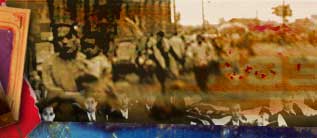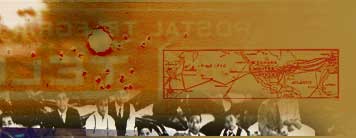CONTENTS OF THE FILE
OF SUN YAT SEN
The historical INS case file for Sun Yat-sen does not contain a complete record of his arrivals in Honolulu and the mainland United States. It documents mainly his arrival on a crucial trip during 1904, though there are also documents of interest dated as late as 1925.
This priceless file appears remarkably similar to the thousands of other immigration case files generated by the Chinese Exclusion laws. Even though Sun Yat-sen became the first president of the Chinese Republic, he evidently fared no better in his dealings with immigration officials than many other Chinese immigrants coming into San Francisco or Honolulu. Particularly of interest in the file are details on how, during his crucial 1904 visit, he successfully outwitted immigration officials and gained entry to the United States in a manner similar to many other Chinese immigrants – through the use of fake information. In this instance, he claimed and presented documentation of his birth not in Choy Hung village, Chungshan District, China, but in Hawaii. Contained in the case file is a "birth certificate" issued by the Secretary of the Territory of Hawaii on March 14, 1904, and certifying that the applicant was born in Ewa, Oahu, on November 24, 1870 (Dr. Sun is known to have been born in 1866).
According to the case file, on April 6, 1904, Sun Yat-sen landed in San Francisco, where, like other Chinese immigrants not included in the "exempt class" of government officials, teachers, merchants, and students, he was detained for investigation by the Bureau of Immigration. Among the three photographs of him included in the file is a typical "initial arrival" photograph of the applicant holding a "chalkboard" on which is recorded his original Hawaiian case file number, C-140. Also included is a Hawaiian territorial passport documenting Dr. Sun’s status as a U.S. citizen.
However, within a few days of his arrival, Sun Yat-sen was informed "that after due consideration of your case the Honorable Commissioner of Immigration has refused you admission to the United States." Dr. Sun was requested to sign the decision document, issued on April 16, 1904, and was advised that he could appeal the denial to the secretary of the Department of Commerce and Labor if the appeal were filed within two days. He was refused admission on the grounds that he had waived his rights as a citizen of the United States and become a subject of China. This reasoning is found in a letter of April 15, 1904, from the Office of the Commissioner, Immigration Service, to the Chinese Inspector in Charge, San Francisco. The letter also summarizes the testimony, found in the file, of Dr. Sun during his interrogation by the Bureau of Immigration.
The testimony of applicant is found on pages 3, 4, 7, and 8 of the record. He states in brief that he was born in the Hawaiian Islands 34 years ago, at a place called Ewa; that when he was very young, to wit 3 or 4 years of age, with his parents he went to China, where his father died; that when about 10 years of age he returned to Honolulu, accompanied by his mother and remained there in school until he was between 16 or 17 years of age, when he again went to China, remaining there for 7 or 8 years, and for a second time went back to the Hawaiian islands, that he again went to Hong Kong and studied medicine, and in fact has visited Hong Kong a number of times; that in 1896 he came to this port and was landed on Section 6 papers issued to him in Shanghai in 1895 or 1896, as a Chinese subject, the same being in form of a traveler’s Section 6 Certificate; that upon his admission here in 1896 he went to London, England by way of New York, and from there finally back to Honolulu, where he was landed in February, 1901, as a native born citizen, and without any papers; that since that time he has done nothing to again become a citizen of the United States, excepting to swear allegiance to the United States before receiving the passport heretofore mentioned. Further, that both his parents were full blooded Chinese subjects.
The commissioner goes on to say that "from his own statement he waived his right to American citizenship and was in 1895 or 1896 a subject of China, and was landed here upon a Section 6 traveler’s Shanghai certificate, which, according to my understanding of the law, could only be issued to a Chinese subject."
Thus, Dr. Sun’s application to land was denied, and he was "ordered deported to the port whence he came upon the departure of the next vessel of the line bringing him here." The 1904 landing records are significant because they support other documentation concerning the now-famous incident in which, pending future action, Dr. Sun was held incommunicado in the wooden immigration shed. He was able to "smuggle out" a note via an American newsboy, which resulted in assistance from pioneer publisher Ng Poon Chew and the Chee Kung Tong. It is also interesting that nothing is noted in the case file documents regarding a portrayal of Dr. Sun as a bandit by his enemies, which, according to historians citing revolutionary accounts, may have been furnished to the INS at this time.
Fortunately for the history of China, Sun Yat-sen, represented by the Washington, D.C., law firm of Ralston and Siddons, filed an appeal with the Commissioner-General of Immigration n April 26, 1904. On April 28, 1904, the acting secretary of the Department of Commerce and Labor, in a four-page decision contained in the case file, set aside the order of deportation and ordered the Commissioner of Immigration in San Francisco to "permit the said Sun Yat-sen to land." The reasoning in this document is that since San Francisco District had not disputed Dr. Sun’s claim to Hawaiian birth in 1896 when he reached San Francisco from Hawaii (strangely, the birthplace is cited in this document as Maui), U.S. citizenship must be conferred upon him under the act of April 30, 1900 (31 Stat 141) by virtue of his status as a Hawaiian citizen. He must therefore be allowed to land. Thus, rather than facing deportation and certain death in China, Dr. Sun was freed to embark on his second famous fund-raising tour of the United States.
The case file is silent about Sun Yat-sen’s activities in the United States between 1909 and 1911, including the fateful 1911 trip that started with arrival in San Francisco. Later in Denver he learned of the outbreak of the revolution and in St. Louis, of his appointment as president of the Provisional Republic of China.
The remainder of the case file sheds light on the post-1911 period. It contains information on U.S. and official Peking policies and attitudes toward Sun Yat-sen and on options considered by Sun Yat-sen, rather than confirmation of any subsequent visits.
For instance, in a letter of June 27, 1912, Richard L. Halsey, inspector in charge at the Honolulu Immigration Station, sought the advice of the Commissioner-General of Immigration in Washington about a proposed visit of the former first president of the Chinese Republic to Honolulu. Halsey asked "whether by assuming that office he forfeited his American citizenship, and as to whether it is incumbent upon us to demand the papers that are necessary in the case of alien Chinese."
The Commissioner-General advised Halsey on July 16, 1912, that even though Sun "fully established his status as a Chinese citizen by becoming the provisional president of the new republic, so clearly is he a person whose exclusion from the United States was never contemplated by the treaty, laws, and regulations, that it is deemed that official cognizance should be taken of his generally recognized status and standing." Halsey was ordered to "admit Sun Yat-sen immediately on arrival." There is no record in the file of an actual landing.
Dr. Sun’s recognized status perplexed immigration officials further in 1914. On January 23, the Honolulu District received the following telegram from Washington: "Sun Yat-sen subject department decision twenty arrives Honolulu, twenty-fourth, traveling and holding passport as Japanese. Department understands he now claims Chinese birth. Examine under exclusion laws but observe care in identifying him not to cause annoyance to other Japanese passengers."
 
|





